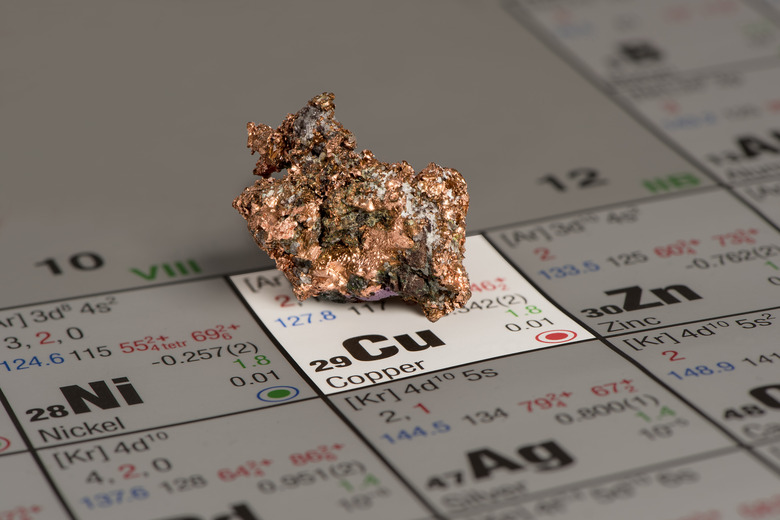What Determines The Chemical Behavior Of An Atom?
Elements are made of atoms, and the structure of the atom determines how it will behave when interacting with other chemicals. The key in determining how an atom will behave in different environments lies in the arrangement of electrons within the atom.
TL;DR (Too Long; Didn't Read)
When an atom reacts, it can gain or lose electrons, or it can share electrons with a neighboring atom to form a chemical bond. The ease with which an atom can gain, lose or share electrons determines its reactivity.
Atomic Structure
Atomic Structure
Atoms consist of three types of subatomic particle: protons, neutrons and electrons. The identity of an atom is determined by its proton number or atomic number. For example, any atom having 6 protons is classed as carbon. Atoms are neutral entities, so they always have equal numbers of positively charged protons and negatively charged electrons. The electrons are said to orbit the central nucleus, held in position by the electrostatic attraction between the positively charged nucleus and the electrons themselves. The electrons are arranged in energy levels or shells: defined areas of space around the nucleus. Electrons occupy the lowest available energy levels, that is to say the closest to the nucleus, but each energy level can only contain a limited number of electrons. The position of the outermost electrons is key in determining the behavior of an atom.
Full Outer Energy Level
Full Outer Energy Level
The number of electrons in an atom is determined by the number of protons. This means most atoms have a partially filled outer energy level. When atoms react, they tend to try and achieve a full outer energy level, either by losing outer electrons, by gaining extra electrons or by sharing electrons with another atom. This means it is possible to predict the behavior of an atom by examining its electron configuration. Noble gases such as neon and argon are notable for their inert character: They do not take part in chemical reactions except under very extreme circumstances as they already have a stable full outer energy level.
The Periodic Table
The Periodic Table
The Periodic Table of the Elements is arranged so that elements or atoms with similar properties are grouped in columns. Each column or group contains atoms with a similar electron arrangement. For example, elements such as sodium and potassium in the left-hand column of the Periodic Table each contain 1 electron in their outermost energy level. They are said to be in Group 1, and because the outer electron is only weakly attracted to the nucleus, it can be lost easily. This renders Group 1 atoms highly reactive: They readily lose their outer electron in chemical reactions with other atoms. Similarly, elements in Group 7 have a single vacancy in their outer energy level. Since full outer energy levels are the most stable, these atoms can readily attract an additional electron when they react with other substances.
Ionisation Energy
Ionisation Energy
Ionization energy (I.E.) is a measure of the ease with which electrons can be removed from an atom. An element with a low ionization energy will react readily by losing its outer electron. Ionization energy is measured for the successive removal of each electron of an atom. The first ionization energy refers to the energy required to remove the first electron; the second ionization energy refers to the energy required to remove the second electron and so on. By examining the values for successive ionization energies of an atom, its likely behavior can be predicted. For example, the Group 2 element calcium has a low 1st I.E. of 590 kilojoules per mole and a relatively low 2nd I.E. of 1145 kilojoules per mole. However, the 3rd I.E. is much higher at 4912 kilojoules per mole. This suggests that when calcium reacts it is most likely to lose the first two easily removable electrons.
Electron Affinity
Electron Affinity
Electron affinity (Ea) is a measure of how easily an atom can gain extra electrons. Atoms with low electron affinities tend to be very reactive, for example fluorine is the most reactive element in the Periodic Table and it has a very low electron affinity at -328 kilojoules per mole. As with ionization energy, each element has a series of values representing the electron affinity of adding the first, second and third electrons and so on. Once again, the successive electron affinities of an element give an indication of how it will react.
Cite This Article
MLA
Mitchell, Veronica. "What Determines The Chemical Behavior Of An Atom?" sciencing.com, https://www.sciencing.com/determines-chemical-behavior-atom-7814766/. 23 April 2018.
APA
Mitchell, Veronica. (2018, April 23). What Determines The Chemical Behavior Of An Atom?. sciencing.com. Retrieved from https://www.sciencing.com/determines-chemical-behavior-atom-7814766/
Chicago
Mitchell, Veronica. What Determines The Chemical Behavior Of An Atom? last modified August 30, 2022. https://www.sciencing.com/determines-chemical-behavior-atom-7814766/
